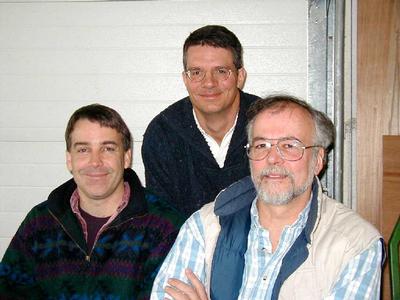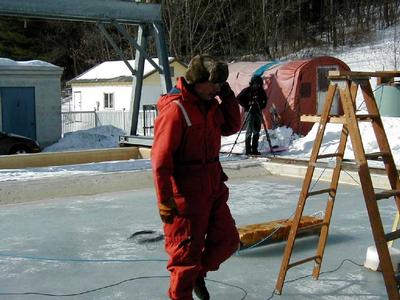4 April, 2001
Visiting Research Team from the Naval Undersea Warfare Center
Roy Manstan, Paul Mileski and Pat Gilles are communications specialists
working for the Naval Undersea Warfare Center (NUWC), a research laboratory
in Newport, Rhode Island. They are only three members of a self-sufficient
field engineering team of six who profile the scientific component of
military and civilian technology. This team is using the Cold Regions
Research and Engineering Laboratory's (CRREL) unique facilities this week to
conduct tests in cutting-edge submarine antennae systems. The research may
ultimately provide emergency communications and improve navigation in the
Arctic.
In addition to the collection of scientific data for their mission
assignments; Roy, Paul and Pat have made it their personal group goal to
maximize their moments of down time for the promotion of education.
Looking at ways to interact with the local communities, especially schools,
and investigating ways to interpret and profile science as it is occurring
in the field while transmitting it to the public domain has its challenges.
What students see is real time data collection, not a TV show.
This educationally progressive team is capturing technology developed by a
military sponsor and translating it into a humanitarian effort. These
public outreach activities are conducted on a not-to-interfere basis (not to
interfere with their job assignment). This enthusiastic team is looking for
ways to gradually become funded in military educational outreach so they can
expand the scope of their (and the Navy's) educational endeavors.
I was invited to observe the live communications Roy, Paul and Pat conducted
for the American School for the Deaf in West Hartford, Connecticut while
they conducted their tests and data documentation. Using his cell phone,
Paul gave a running dialogue to signing teachers in the school's auditorium
where the entire student body had gathered to watch on large screens. Pat,
Roy and the rest of the NUWC team operated the cameras, test equipment and
data collection systems, and conducted SCUBA diving operations under the
ice. Throughout this process, students asked questions while watching both
the above water and underwater video sent live via the Internet.
After the testing phase, the four of us chatted about educational outreach
and the team's goals and challenges. Roy's educational link to the American
School for the Deaf began with personal connections and an interest in
attracting the deaf to careers in science, mathematics and technology. Roy
observes that, unfortunately, the families of the deaf and consequently the
deaf themselves sometimes maintain an attitude of limitations. The deaf are
highly capable and must not limit themselves in career opportunities and the
contributions they can make toward science and technology.
By Sandra Kolb, March 2001

Left to right: Pat Gilles, Paul Mileski and Roy Manstan from the Naval Undersea Warfare Center (NUWC) of Newport, Rhode Island. Photo by Sandra Kolb.

Paul Mileski on the cell phone and Pat Gilles behind the tripod documenting their live test for the navy and communicating this field experiment to the American School for the Deaf. Photo by Sandra Kolb.

Left to right: Divers Bruce Greenhalgh and Jack Hughes preparing for the test with John Wiedenheft assisting. Roy Manstan in the background. Photo by Sandra Kolb.
Contact the TEA in the field at
.
If you cannot connect through your browser, copy the
TEA's e-mail address in the "To:" line of
your favorite e-mail package.
|
